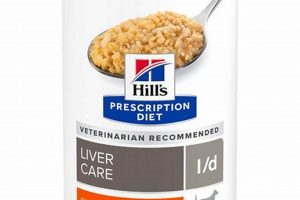Specific dietary formulations exist to assist in the management of canine diabetes. These products are designed to help regulate blood glucose levels through controlled carbohydrate content, increased fiber, and appropriate protein and fat ratios. These formulations are available from various manufacturers and are often recommended by veterinarians as part of a comprehensive treatment plan for diabetic dogs.
The use of specialized diets in managing canine diabetes is crucial for minimizing fluctuations in blood sugar, reducing the reliance on insulin injections, and promoting overall well-being. Historically, dietary management was a cornerstone of diabetes treatment, and advancements in nutritional science have led to more sophisticated and effective food options. These advancements offer pet owners a practical tool for managing their dog’s condition.
This article explores the characteristics of suitable dietary options for managing diabetes in canines. Further discussion will include factors to consider when choosing the appropriate food, potential benefits of these options, and the importance of consulting with a veterinarian to tailor a specific dietary plan for each individual dog’s needs.
Dietary Management for Canine Diabetes
Implementing a structured dietary approach is vital for managing diabetes in dogs. Consistency and adherence to veterinary recommendations are key for optimal blood glucose control.
Tip 1: Maintain Consistent Meal Times: Feeding the dog at the same times each day helps regulate insulin requirements and prevents significant fluctuations in blood glucose levels. A consistent feeding schedule complements insulin therapy, optimizing its effectiveness.
Tip 2: Portion Control is Crucial: Carefully measure each meal to ensure consistent caloric intake. Overfeeding can lead to weight gain and increased insulin resistance, complicating diabetes management. Underfeeding can result in hypoglycemia, requiring immediate intervention.
Tip 3: Fiber Content Matters: Select foods with a high fiber content. Fiber slows glucose absorption, leading to a more gradual rise in blood sugar after meals. This can help stabilize blood glucose levels throughout the day.
Tip 4: Monitor Water Intake: Diabetic dogs often experience increased thirst. Ensure constant access to fresh water. Changes in water consumption can be an indicator of blood glucose instability and should be reported to a veterinarian.
Tip 5: Limit Treats and Snacks: Avoid giving treats or snacks that are high in sugar or carbohydrates. If treats are necessary, choose diabetic-friendly options recommended by a veterinarian. Account for the calories from treats when calculating daily food intake.
Tip 6: Regular Veterinary Check-Ups: Routine visits to the veterinarian are essential for monitoring blood glucose levels and adjusting the treatment plan as needed. Blood glucose curves and fructosamine tests provide valuable information about diabetes control.
Tip 7: Avoid Sudden Dietary Changes: Introduce any new food gradually to avoid gastrointestinal upset. Abrupt changes in diet can impact blood glucose levels and complicate diabetes management. Consult with a veterinarian before making any significant alterations to the dog’s diet.
Consistent dietary management is a cornerstone of effective diabetes control in dogs. Adherence to these tips, in conjunction with veterinary guidance, can significantly improve the quality of life for diabetic canines.
The subsequent section will delve into the importance of prescription diets and their role in managing this condition.
1. Glucose Regulation
Effective management of canine diabetes relies heavily on precise glucose regulation. Specialized dietary formulations, such as those produced by Purina for diabetic dogs, play a critical role in achieving and maintaining stable blood glucose levels.
- Controlled Carbohydrate Content
Dietary strategies for diabetic dogs often involve restricting the intake of simple carbohydrates. Purina’s diabetic formulations typically contain a specific, measured amount of carbohydrates designed to minimize postprandial glucose spikes. This controlled approach helps prevent rapid elevations in blood sugar after meals, which can be detrimental to diabetic canines.
- Fiber’s Role in Glucose Absorption
Increased fiber content is a hallmark of many diabetic dog foods. Fiber slows down the absorption of glucose from the digestive tract, leading to a more gradual and sustained release of glucose into the bloodstream. This, in turn, helps avoid drastic fluctuations in blood glucose levels, promoting greater stability throughout the day. Purina’s products often incorporate appropriate levels of fiber to achieve this effect.
- Protein and Fat Balance
The balance of protein and fat in the diet also influences glucose regulation. High-protein diets can help support lean muscle mass, which is important for metabolic health. Moderate fat content provides energy without contributing to excessive weight gain, which can worsen insulin resistance. Purina’s formulations strive to maintain an optimal protein-to-fat ratio tailored for diabetic dogs.
- Consistent Meal Timing and Portion Control
Even with a suitable dietary formulation, consistent meal timing and portion control are essential for effective glucose regulation. Feeding the dog at the same times each day and providing the correct amount of food, as recommended by a veterinarian, helps synchronize insulin administration with glucose availability. Irregular feeding patterns can disrupt blood glucose control, negating some of the benefits of a specialized diet.
These facets highlight the multifaceted approach to glucose regulation employed within specialized diets. Veterinary guidance remains essential to ensure that Purina’s diabetic formulations are integrated into a comprehensive management plan for each individual dog, maximizing the potential for achieving stable and well-controlled blood glucose levels. Dietary strategies remain a cornerstone for managing diabetes in canines.
2. Fiber Enrichment
Fiber enrichment is a key component in managing canine diabetes through dietary intervention. Specialized diets, including certain Purina formulations designed for diabetic dogs, incorporate enhanced fiber content to help regulate blood glucose levels and promote overall metabolic health. The strategic use of fiber offers several benefits that contribute to effective diabetes management.
- Slowing Glucose Absorption
The primary benefit of fiber enrichment in diabetic dog food is its ability to slow the absorption of glucose from the digestive tract. Fiber forms a viscous gel in the intestines, delaying the rate at which carbohydrates are broken down and absorbed into the bloodstream. This results in a more gradual and sustained rise in blood glucose levels after meals, preventing the sharp spikes that can be detrimental to diabetic dogs. Examples include the incorporation of beet pulp or cellulose in the food.
- Promoting Satiety and Weight Management
Fiber has a high satiety value, meaning it helps dogs feel fuller for longer periods. This can be particularly beneficial for diabetic dogs who may have a tendency to overeat or gain weight. Maintaining a healthy weight is crucial for managing insulin resistance, a common issue in diabetic canines. Fiber enrichment aids in weight management by reducing overall caloric intake and preventing excessive weight gain. Specific types of insoluble fiber add bulk to the food without adding significant calories.
- Supporting Digestive Health
Fiber plays an important role in maintaining a healthy digestive system. It promotes regular bowel movements, preventing constipation and supporting the growth of beneficial gut bacteria. A healthy gut microbiome can indirectly influence glucose metabolism and insulin sensitivity. Purina’s formulations may contain a blend of soluble and insoluble fibers to optimize digestive health in diabetic dogs.
- Influence on Insulin Sensitivity
While the exact mechanisms are still being researched, some studies suggest that certain types of fiber may improve insulin sensitivity. By modulating the gut microbiome and reducing inflammation, fiber may enhance the body’s response to insulin, leading to better blood glucose control. Specific prebiotics, a type of soluble fiber, support beneficial gut bacteria and improve insulin sensitivity. It is essential to note that the effects of fiber on insulin sensitivity may vary depending on the type of fiber and the individual dog’s physiology.
In summary, fiber enrichment serves as a multifaceted approach to managing canine diabetes. By slowing glucose absorption, promoting satiety, supporting digestive health, and potentially improving insulin sensitivity, fiber contributes significantly to overall metabolic well-being. When integrated into a Purina formulation specifically designed for diabetic dogs, and under the guidance of a veterinarian, fiber enrichment becomes a crucial element in a comprehensive diabetes management plan, maximizing the potential for stable blood glucose control and improved quality of life.
3. Veterinary Recommendation
The selection of appropriate nutritional interventions for diabetic dogs is a matter requiring professional veterinary guidance. While specific commercial diets, including those marketed as “Purina dog food for diabetic dogs,” may seem readily available, their suitability depends on several factors unique to the individual canine patient. The cause-and-effect relationship is clear: incorrect dietary choices can exacerbate diabetic complications, while a veterinarian-recommended diet is a critical component of comprehensive diabetes management. The veterinarian considers the dog’s breed, age, weight, activity level, concurrent health conditions, and response to insulin therapy. For example, a seemingly appropriate high-fiber diet might be unsuitable for a dog with pre-existing gastrointestinal sensitivities. Therefore, a recommendation is not merely a preference but a clinical judgment based on a thorough assessment.
The importance of a veterinary recommendation extends beyond initial diet selection. Regular monitoring and adjustments are often necessary. Blood glucose curves, fructosamine levels, and overall clinical signs are evaluated to determine the diet’s effectiveness. A veterinarian may adjust the diet’s composition, quantity, or feeding schedule based on these parameters. Consider a scenario where a diabetic dog initially responds well to a specific “Purina” formulation. Over time, however, its insulin requirements increase. The veterinarian may then recommend a different formulation with a lower carbohydrate content or adjust the insulin dosage, emphasizing the need for ongoing professional oversight. Such tailored adjustments are not possible without consistent veterinary involvement.
In conclusion, a veterinary recommendation is an indispensable aspect of utilizing “Purina dog food for diabetic dogs” or any specialized diet. It mitigates the risks associated with inappropriate dietary choices, ensures the diet aligns with the individual dog’s needs, and facilitates ongoing monitoring and adjustments to optimize diabetes management. Challenges, such as pet owners relying solely on online information or marketing claims, underscore the vital role of veterinary expertise. The broader theme revolves around recognizing diabetes management as a complex medical undertaking requiring a collaborative approach between the veterinarian and the pet owner.
4. Weight Management
Weight management is intrinsically linked to the effective management of canine diabetes mellitus. Excess weight exacerbates insulin resistance, a central characteristic of diabetes, while maintaining a healthy weight improves glycemic control and reduces the reliance on exogenous insulin. Diets specifically formulated for diabetic dogs, including certain Purina offerings, often prioritize weight management through controlled calorie content, appropriate macronutrient ratios, and the inclusion of dietary fiber. The rationale is clear: obesity intensifies the body’s resistance to insulin, necessitating higher insulin doses to achieve the same level of blood glucose control. This, in turn, increases the risk of hypoglycemia and other complications. Therefore, weight reduction, when appropriate, becomes a critical therapeutic target.
The composition of “Purina dog food for diabetic dogs” reflects this emphasis on weight management. These formulations typically feature a higher protein content, which supports lean muscle mass and promotes satiety, and a moderate fat content to provide energy without contributing to excessive calorie intake. Fiber, as previously discussed, plays a crucial role in promoting satiety and slowing glucose absorption, both of which contribute to effective weight management. A case study involving a diabetic Labrador Retriever demonstrates the practical significance of this approach. The dog, initially overweight and requiring high doses of insulin, experienced a significant reduction in insulin requirements and improved glycemic control after being transitioned to a calorie-controlled, high-fiber diabetic diet. This outcome underscores the synergistic effect of dietary composition and weight management in achieving optimal diabetes control.
Effective weight management in diabetic dogs is not solely reliant on dietary formulation but also requires diligent monitoring and adherence to feeding guidelines. Owners must carefully measure food portions, avoid overfeeding, and provide regular exercise. Furthermore, periodic weight checks and body condition scoring by a veterinarian are essential to track progress and adjust the dietary plan as needed. Challenges arise when owners struggle to resist giving treats or fail to adhere to the prescribed feeding schedule. Overcoming these challenges requires consistent communication between the veterinarian and the pet owner, emphasizing the importance of weight management as an integral component of the dog’s overall diabetes management plan. The practical significance of this understanding lies in the improved quality of life for the diabetic dog, characterized by better glycemic control, reduced insulin requirements, and a lower risk of complications.
5. Consistent Formulation
The consistent formulation of “Purina dog food for diabetic dogs” is not merely a manufacturing detail; it is a critical element in managing a complex metabolic condition. Fluctuations in ingredient ratios, nutrient levels, or the source of ingredients can introduce instability in blood glucose control. For a diabetic dog, even subtle variations can disrupt the delicate balance achieved through insulin therapy and dietary management. The cause-and-effect relationship is direct: inconsistent formulation leads to unpredictable glycemic responses, complicating the task of regulating blood sugar levels. This predictability is essential for veterinarians to accurately prescribe and adjust insulin dosages. A diabetic dog stabilized on a specific “Purina” formula relies on the assurance that each bag or can delivers the same nutritional profile. This is achieved through stringent quality control measures and adherence to precise manufacturing protocols.
The practical significance of consistent formulation extends to several aspects of diabetes management. It allows for reliable monitoring of blood glucose responses to dietary changes. It simplifies the process of titrating insulin dosages, as veterinarians can attribute changes in blood glucose levels to factors other than dietary inconsistencies. Moreover, it reduces the risk of hypoglycemic or hyperglycemic episodes, which can have serious consequences for the dog’s health. Consider the example of a diabetic dog whose blood glucose is well-controlled on a specific “Purina” formulation. If, without the owner’s knowledge, the manufacturer alters the formula, the dog could experience unexpected spikes or drops in blood sugar, leading to clinical signs such as weakness, lethargy, or even seizures. This highlights the importance of rigorous adherence to consistent formulation standards and transparent communication from manufacturers regarding any changes to their products.
In conclusion, the consistent formulation of “Purina dog food for diabetic dogs” is a cornerstone of effective diabetes management. It ensures predictable glycemic responses, simplifies insulin dosage adjustments, and reduces the risk of dangerous blood glucose fluctuations. Challenges, such as ingredient sourcing variations or manufacturing errors, underscore the need for robust quality control measures and transparent communication from manufacturers. The broader theme revolves around recognizing diabetes management as a multifaceted endeavor requiring precision, consistency, and a collaborative approach between veterinarians, pet owners, and food manufacturers. This focus is essential for maintaining the health and well-being of diabetic canines.
Frequently Asked Questions About Dietary Management of Canine Diabetes
This section addresses common inquiries concerning the utilization of specialized dietary formulations in the management of canine diabetes mellitus. These responses aim to provide clear, informative guidance based on established veterinary medical principles.
Question 1: Is “Purina dog food for diabetic dogs” a cure for diabetes?
No. These formulations are not a cure. They are a management tool designed to help regulate blood glucose levels in conjunction with other therapies, such as insulin administration. Diabetes mellitus is a chronic condition requiring ongoing management.
Question 2: Can “Purina dog food for diabetic dogs” eliminate the need for insulin injections?
In some mild cases of diabetes, dietary management alone may reduce the need for insulin, but this is not typical. Most diabetic dogs will require insulin injections to maintain adequate blood glucose control. The diet is designed to complement insulin therapy, not replace it.
Question 3: How quickly will “Purina dog food for diabetic dogs” lower a dog’s blood sugar?
The effects are not immediate. It typically takes several days to weeks to see the full impact of a dietary change on blood glucose levels. Regular monitoring of blood glucose is essential during this transition period to adjust insulin dosages as needed.
Question 4: Are all “Purina” dog food products labeled for diabetic dogs suitable for every diabetic dog?
No. Individual needs vary. A veterinarian must assess the dog’s specific condition, including weight, concurrent illnesses, and insulin requirements, to determine the most appropriate dietary formulation. A veterinarian should always be consulted prior to making dietary changes for a diabetic dog.
Question 5: Can treats be given to a diabetic dog eating “Purina dog food for diabetic dogs?”
Treats should be limited and carefully selected. High-sugar or high-carbohydrate treats should be avoided. Diabetic-friendly treats, as recommended by a veterinarian, may be given in moderation, but their caloric content should be factored into the dog’s overall daily caloric intake.
Question 6: What happens if a diabetic dog refuses to eat “Purina dog food for diabetic dogs?”
If a dog refuses to eat the prescribed diet, it is crucial to consult a veterinarian. Alternative dietary options may need to be explored. Force-feeding should be avoided, as it can lead to food aversion and other complications. The veterinarian may recommend strategies to improve palatability or suggest a different formulation that the dog finds more appealing.
Dietary management is a complex aspect of canine diabetes care. This information is intended for educational purposes only and does not substitute for professional veterinary advice.
The following section will address advanced nutritional strategies and future trends in dietary management for canine diabetes.
Dietary Intervention
This discussion has examined the role of specialized dietary formulations, including those marketed as “Purina dog food for diabetic dogs,” in the comprehensive management of canine diabetes mellitus. The regulation of blood glucose, through controlled carbohydrate content and fiber enrichment, represents a critical aspect of these diets. Veterinary recommendation is paramount, ensuring that dietary choices align with the individual needs of each canine patient. Weight management, facilitated by appropriate macronutrient ratios and portion control, further contributes to improved glycemic control. Consistent formulation across product batches is essential for predictable metabolic responses, enabling accurate insulin dosage adjustments. These elements, when integrated effectively, form a robust foundation for managing this complex metabolic disorder.
Optimal outcomes in canine diabetes management are contingent upon a multifaceted approach, encompassing precise insulin therapy, consistent monitoring, and, as emphasized herein, carefully selected dietary interventions. Pet owners are encouraged to engage proactively with their veterinarians, collaborating to develop and implement personalized management plans that prioritize the long-term health and well-being of their diabetic canine companions. Continued research and advancements in veterinary nutrition hold the promise of even more effective dietary strategies in the future, potentially mitigating the challenges associated with this prevalent endocrine disease.


![Evolve Dog Food: Is It Really Good? [Review] World’s Most Delicious Foods: Must-Try Dishes from Every Country Evolve Dog Food: Is It Really Good? [Review] | World’s Most Delicious Foods: Must-Try Dishes from Every Country](https://lisasfoods.com/wp-content/uploads/2025/12/th-714-300x200.jpg)




